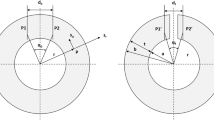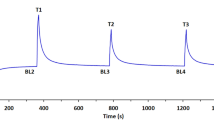Abstract
The aim of this study was to evaluate the degree of conversion (DC) and to identify the viscoelastic properties: storage modulus (E’), loss modulus (E”), tangent delta (tan δ), and glass transition temperature (T g ) of a microhybrid resin-composite light-activated by three different protocols. A Filtek Z250 (3 M ESPE) shade A3 was inserted in a Teflon mold (21 mm × 5 mm × 1 mm for viscoelastic properties; and 5 mm × 1 mm for DC) and light-activated according to the following light-activation protocols: (S) 1,000 mW/cm2 × 19 s, (HP) 1,400 mW/cm2 × 14 s, and (PE) 3,200 mW/cm2 × 6 s, all set up to deliver 19 J/cm2. Viscoelastic properties was assessed by dynamic mechanical analysis (DMA) (n = 3), performed in single cantilever clamped mode. DC (n = 5) was measured by FTIR on top (T) and bottom (B) surfaces, and the data was submitted to a split-plot one-way ANOVA. For DC, there was a significant effect for surface factor and light-activation protocols factor. Top surface showed higher DC than B in all experimental conditions. Light-activation protocols S and HP resulted in higher DC than PE and were similar between them. Viscoelastic properties (E’, E”, tan δ, T g ) were not affected by light-activation protocols. It could be concluded that light-activation protocols influenced DC but not influenced the viscoelastic properties.



Similar content being viewed by others
References
Leprince GJ, Palin WM, Hadis MA, Devaux J, Leloup G (2013) Progress in dimethacrylate-based dental composite technology and curing efficiency. Dent Mater 29:139–156
Asmussen E, Peutzfeldt A (2001) Influence of pulse-delay curing on softening of polymer structures. J Dent Res 80:1570–1573
Ferracane JL (2011) Resin composite—state of the art. Dent Mater 27:29–38
Rueggeberg FA (2011) State-of-the-art: dental photocuring—a review. Dent Mater 27:39–52
Peutzfeldt A, Asmussen E (2005) Resin composite properties and energy density of light cure. J Dent Res 84:659–662
Soh MS, Yap AUJ (2004) Influence of curing modes on crosslink density in polymer structures. J Dent 32:321–326
Hansen EK, Asmussen E (1993) Correlation between depth of cure and surface hardness of light-activated resin. Scand J Dent Res 101:62–64
Atmadja G, Bryant RW (1990) Some factors influencing the depth of cure of visible light-activated composite resins. Aust Dent J 35:213–218
Rode KM, Kawano Y, Turbino ML (2007) Evaluation of curing light distance on resin composite microhardness and polymerization. Oper Dent 32:571–578
Aguiar FHB, Oliveira TRV, Lima DANL, Ambrosano GM, Lovadino JR (2008) Microhardness of different thicknesses of resin composite polymerized by conventional photocuring at different distances. Gen Dent 56:144–148
Lima AF, Andrade KMG, Alves LEC, Soares GP, Marchi GM, Aguiar FHB, Peris AR, Mitsui FHO (2012) Influence of light source and extended time of curing on microhardness and degree of conversion of different regions of a nanofilled composite resin. Eur J Dent 6:153–157
Feng L, Carvalho R, Sush BI (2009) Insufficient cure under the condition of high irradiance and short irradiation time. Dent Mater 25:283–289
Asmussen E, Peutzfeldt A (2001) Influence of selected components on crosslink density in polymer structures. Eur J Oral Sci 109:282–285
Asmussen E, Peutzfeldt A (2003) Two-step curing: influence on conversion and softening of a dental polymer. Dent Mater 19:466–470
Vouvoudi E, Sideridou ID (2012) Dynamic mechanical properties of dental nanofilled light-cured resin composites: effect of food-simulating liquids. J Mech Behav Biomed Mater 10:87–96
Ferry JD (1980) Viscoelastic properties of polymers, 3rd edn. Wiley, New York
Ngai KL, Roland CM (1993) Intermolecular cooperativity and the temperature dependence of segmental relaxation in semicrystalline polymers. Macromolecules 26:2688–2690
Pascault HS, Verdu J, Williams RJJ (2002) Thermosetting polymers, 1st edn. Marcel Dekker, New York
Enami N, Soderholm KJ (2005) Dynamic mechanical thermal analysis of two light-cured dental composites. Dent Mater 21:977–983
Pistor V, Ornaghi FG, Ornaghi HL, Zattera AJ (2012) Dynamic mechanical characterization of epoxy/epoxycyclohexyl—POSS nanocomposites. Mater Sci Eng A 532:339–345
Acknowledgments
This study was supported by Coordenação de Aperfeiçoamento de Pessoal de Nível Superior, CAPES, Brasil
Author information
Authors and Affiliations
Corresponding author
Rights and permissions
About this article
Cite this article
Giorgi, M.C.C., Pistor, V., Mauler, R.S. et al. Influence of light-activation protocol on methacrylate resin-composite evaluated by dynamic mechanical analysis and degree of conversion. Lasers Med Sci 30, 1219–1223 (2015). https://doi.org/10.1007/s10103-014-1572-x
Received:
Accepted:
Published:
Issue Date:
DOI: https://doi.org/10.1007/s10103-014-1572-x




